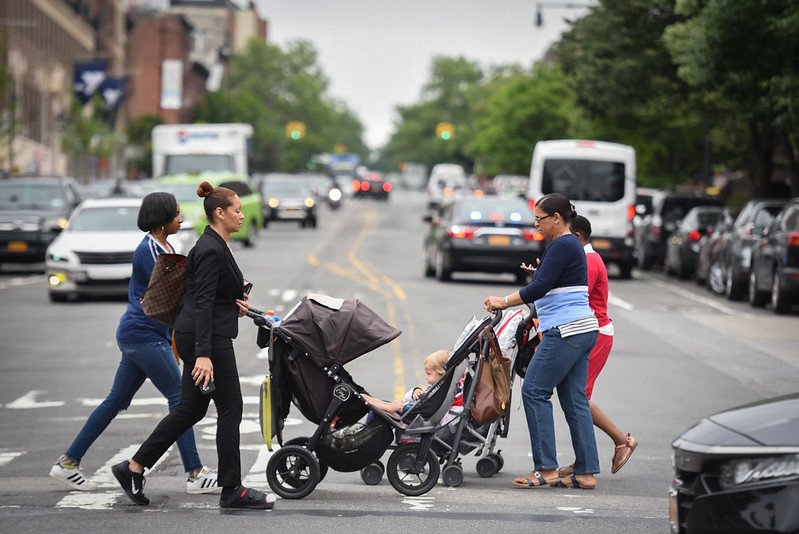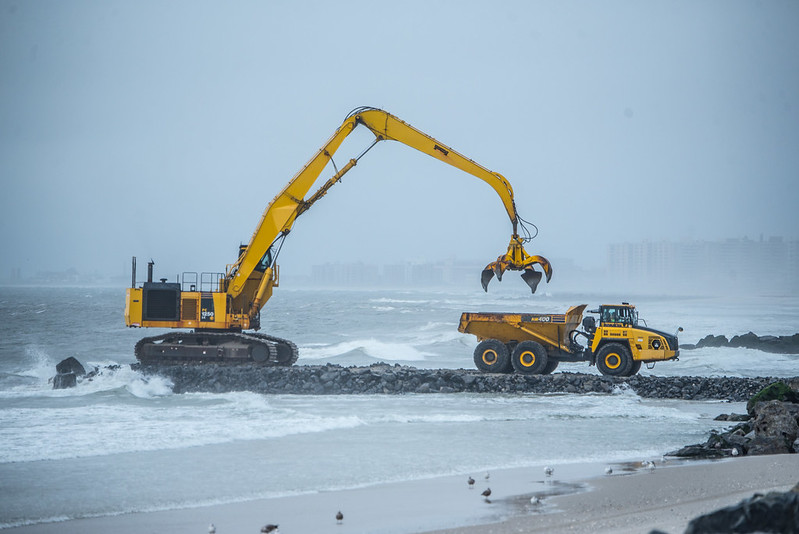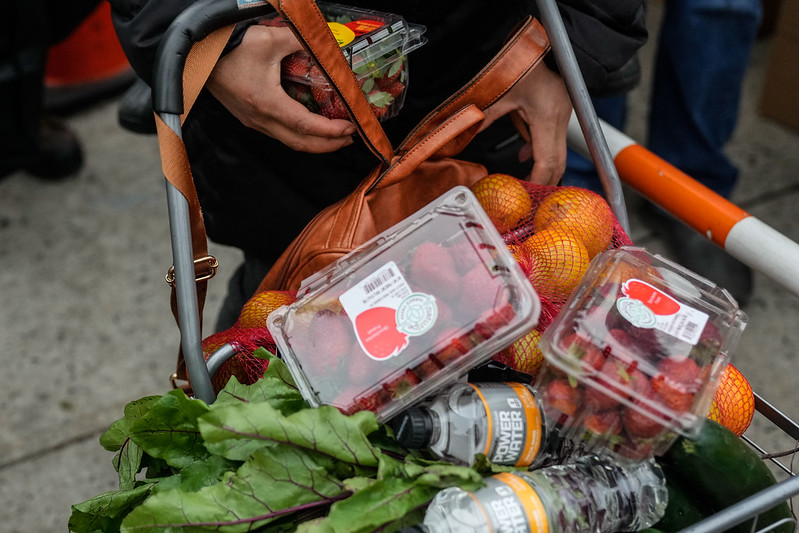We’ve Lost Children in Preventable Traffic Crashes; Albany Must Let New York City Control Its Streets

Pedestrians on the move (photo: Michael Appleton/Mayoral Photography Office)
Blake Gary was 22 for only seven days.
His room was still filled with birthday streamers and balloons when he left to celebrate with friends. Later that night, he was killed in a car crash, the blue Toyota Corolla twisted around a fire hydrant, flipped upside down, and snapped in two in Hollis, Queens.
At the morgue at Queens County Hospital, we were forced to identify Blake, our family’s oldest child and only son, from just a picture. It’s been almost six years, and we’re still waiting for his belongings — his clothes, shoes, and bag from that night, trapped somewhere in the bureaucracy.
The crash unstitched a community and unraveled a family, but it wasn’t an accident: the street is steep, and consistently and routinely dangerous. Crashes happen here, and across the five boroughs, regularly — someone is killed in a crash on New York City streets every 33 hours. Four years before Blake’s crash, 12-year-old Sammy Cohen Eckstein was killed by a speeding driver on a similarly deadly street. Sammy was just two months shy of his birthday, preparing for his Bar Mitzvah and studying for high school entrance exams – until October 8, 2013.
It doesn’t have to be this way. We can design and build streets and intersections that strengthen our communities — and we can start by passing Sammy’s Law, named for Cohen Eckstein, allowing New York City to control its own speed limits.
Right now, Albany lawmakers decide how fast New York City drivers can travel on New York City roads. New Yorkers have no control over our own speed limits through our local government, even on roads we know are dangerous.
The status quo is deadly. Across the five boroughs, speeding is a major factor in four out of every five crashes that kill people in cars — 30% of pedestrians struck by motor vehicles at an impact speed of 25 MPH will sustain serious injury, and about 12% will die. Even just slightly lower speeds can make a big difference: a pedestrian is four times more likely to be killed by a car going 30 MPH than one traveling 25 MPH.
Fortunately, safer speeds work. Slowing from 30 to 25 MPH reduces the chance of a fatal crash by 78%, and lowering speeds from 25 to 20 MPH has led to a 14% reduction in injurious crashes and a 31% reduction in injuries for both drivers and passengers. Lower speed limits in New York City have already contributed to a 36% decline in pedestrians killed.
New Yorkers support local control for city speed limits, and 72% of New Yorkers believe the City, not Albany, should have the authority to set its own speed limits. The majority supports slower, safer speeds — 68% of voters said they would support seeing the speed limit lowered from 25 to 20 MPH on residential streets near their homes.
We can make this a reality — and all eyes are on Assembly Speaker Carl Heastie and his colleagues to make it happen. Both Governor Hochul and the State Senate have shown leadership on this, and included legislation for lower speed limits in their proposed budgets, but we need Albany to step up as a whole and include this critical bill in the final state budget — which is being negotiated right now and due by or around the April 1 start of the new state fiscal year.
Safer speeds could have saved Blake’s and Sammy’s lives – but if you drive by 100th Avenue near 205th Place in Queens, you’d never know. We can’t put anything down to keep Blake’s memory alive; the crash happened on someone else’s private property, so there’s no sign, no cross, no memorial, nothing tangible to remind the world Blake Gary existed. The street itself remains deadly — bent and steep, without even a speed bump, a lower speed limit, or a speed safety camera.
It’s said often because it’s true: losing a child is the worst thing that can happen to a parent. The darkness and the suffocating grief is crushing and all-encompassing; it feels impossible to breathe, eat, sleep, survive. Slowly, we began to focus on remembering Blake and Sammy. We joined Families for Safe Streets support groups, where we built lanterns and jewelry boxes and fridge magnets covered in our children’s likeness, their favorite color, their memory. It was here where we met each other and other parents with pain shaped like ours, and we started to demand better, together.
Our children’s deaths were preventable. We can stop this compounding pain, and instead protect other families from losing their children in the same way. The State Assembly must join the State Senate and the Governor in honoring our children by passing Sammy’s Law and allowing our city to control its own speed limits.
***
Denyze Gary and Amy Cohen are two members of Families for Safe Streets and mothers who lost their children to traffic violence. On Twitter @NYC_SafeStreets.
***
Have an op-ed idea or submission for Gotham Gazette? Email This email address is being protected from spambots. You need JavaScript enabled to view it.
The Most Important Infrastructure Project You’ve Never Heard Of: Improving the Massive $52 Billion Flood Protection Plan for NYC

Storm barriers (photo: Michael Appleton/Mayoral Photography Office)
This week, on the heels of the latest sobering United Nations climate change report, the next round of public input will close for one of the largest public infrastructure projects ever to be considered for the New York City region.
The U.S. Army Corps of Engineers is seeking feedback on its $52 billion proposal to protect New York City and the surrounding areas in New York and New Jersey from devastating coastal storms like Hurricane Sandy. And although this project has been progressing for almost a decade, there has been limited attention on this massive initiative, despite its potential to impact millions of New Yorkers and shift the way we interact with our waterfront. It’s time for New Yorkers to secure our future by making sure the Army Corps gets this right.
Hurricane Sandy was the worst natural disaster to ever hit New York City. During the storm, 44 New Yorkers lost their lives, nearly 70,000 homes were damaged, and millions of residents lost power for up to two weeks. Even after the storm subsided, it left devastating impacts in its wake. Thousands of New Yorkers were displaced from their homes, critical public and private infrastructure was damaged, and entire communities were upended. In total, Hurricane Sandy inflicted an estimated $19 billion in damages and lost economic activity across the city. And it showed us just how vulnerable our city is in the face of climate change.
These risks are only growing. Sea levels in the city have already risen by a foot over the last century, and the rapid acceleration of sea level rise over the coming decades means our coastal flooding will only get more frequent and intense. Temperatures are also rising. Intense rainfall events like Hurricane Ida are becoming more common. And the City projected in 2013 that by the 2050s, a Sandy-like storm could cause $90 billion in damage and economic loss – nearly five times Sandy’s impact.
That’s why the Army Corps’ work is so important as one piece of a comprehensive set of preparations for our growing climate risks. This $52 billion conceptual proposal, part of the New York and New Jersey Harbor and Tributaries Study (HATS), is already nearly a decade in the making and assesses a number of potential flood protection measures for an area covering over 2,100 miles of land and affecting nearly 16 million people across the two states. In its tentative recommendations (called Alternative 3B), the Army Corps proposes a series of storm surge barriers and other flood protection measures in key points throughout the New York and New Jersey waterways. Once a concept is approved and funding is secured, the Army Corps will lead a design process through 2030, with measures in place by 2044.
This project presents a once-in-a-lifetime opportunity to install resiliency infrastructure of this scale, which is critical to protect our city against our growing climate risks. As New Yorkers, we must come together to demand that the Army Corps provide these measures as soon as possible and ensure that the designs are improved without adding delays to the process, since every year without flood protections is another year New York City remains at risk of extreme climate impacts.
First and foremost, these flood protection measures must be integrated into the fabric of our city and enhance our public spaces along the waterfront. For example, seawalls can also incorporate an elevated promenade with green space, so that New Yorkers have waterfront access and new public spaces to enjoy. We have already seen other climate resiliency efforts incorporate features and amenities like these for communities to enjoy, such as with the Rockaway Boardwalk and the East Side Coastal Resiliency project.
The designs must not only protect us from storms, but should also clean our water, enhance biodiversity, and guard against sunny-day flooding caused by sea level rise by maximizing the use of nature-based solutions. Green infrastructure such as wetlands and oyster reefs, though insufficient on their own as resiliency measures to protect our city, are a critical part of a holistic and smart resiliency strategy.
In order for this project to be successful, the design process must be community-centered. The Army Corps must meaningfully and thoughtfully engage local and historically underserved communities in impacted neighborhoods. This may include utilizing engagement strategies that go beyond what is standard procedure for federal public engagement processes, such as holding events during non-traditional business hours, providing childcare, or seeking input in locations where communities already meet.
The Army Corps must also prioritize environmental justice by ensuring that historically underserved communities are meaningfully involved, valued, and protected. Environmental justice is too-often devalued in federal cost-benefit analyses, but President Biden’s Justice40 demands a renewed commitment to environmental justice as we confront our climate crisis.
The Army Corps proposal is an unprecedented opportunity to bring together communities and federal, state, and local governments to invest in the future of New York City. We must improve the design for New Yorkers, while advancing without delay the critically-needed protections that this project could bring to our city as the climate changes. The future of our city depends on it.
***
Grace Rauh is the Executive Director of the 5BORO Institute, a think tank bringing together leaders across sectors to find innovative solutions for New York City. Daniel Zarrilli is the former Chief Climate Policy Advisor to the NYC Mayor and a 5BORO board member. On Twitter @GraceRauh & @DZarrilli.
***
Have an op-ed idea or submission for Gotham Gazette? Email This email address is being protected from spambots. You need JavaScript enabled to view it.
Don’t Let SNAP Break: Action Needed at All 3 Levels of Government So Kids Don’t Go Hungry

Access to food (photo: Michael Appleton/Mayoral Photography Office)
Imagine having $100 less every month to buy groceries.
Millions of New Yorkers are now facing that painful reality. They’ll feel it in a thousand ways, big and small. A child who comes to school without breakfast. A mom who skips a meal so her kids have enough to eat. A refrigerator that’s empty because money ran out before the end of the month.
March marked the end of a pandemic-era lifeline that provided extra money for food. Despite record-high prices for basic household necessities, families that live paycheck to paycheck have abruptly been forced to make do with at least $95 less each month.
This immediate cut will hurt.
But as an advocate fighting to end child hunger, I’m worried that an even bigger danger is coming at us.
The more we hear about the debt ceiling fight unfolding in Washington, the clearer it’s become that the millions of kids who rely on food assistance are at greater risk. One of the most important programs we use to fight child hunger is in danger of breaking.
The Supplemental Nutrition Assistance Program (SNAP) is one of the most effective tools we have to feed kids. The average family in the program receives about $230 a month for groceries, usually on a debit card they can use at the supermarket. SNAP has never been enough to cover the full cost of food, especially in places with a high cost of living like New York. But it’s still an enormous help.
Nearly 3 million New Yorkers rely on SNAP to make ends meet.
Earlier this month, lawmakers in the U.S. House of Representatives introduced the America Works Act, a punitive and counterintuitive proposal, which would place limitations on SNAP by tightening work requirements for so-called able-bodied adults without dependents. This proposal would harm individuals who already face obstacles to work – like a lack of stable housing and access to transportation – and doesn’t take into consideration those with undiagnosed physical or mental limitations. It also seeks to impose these stricter requirements on parents and caregivers of children ages seven and older, completely ignoring the realities facing many families on SNAP. We need legislation that helps people put food on the table – not makes it harder to do so.
We desperately need New York’s congressional delegation, especially Senate Majority Leader Schumer and House Democratic Leader Jeffries, to stop any further cuts to SNAP in their tracks. Just like seniors’ health care or Social Security has become a political red line, so should the programs that feed children.
Saving SNAP should be a bipartisan priority, equally important to our leaders from urban and rural districts, upstate and downstate.
But Washington isn’t the only place we need bold action to protect food aid. We need to do more here on the ground in New York as well.
Here in New York City, agencies like the Human Resources Administration (HRA) represent the front door to the SNAP program, processing applications from families. But over the last year, we’ve seen that door close on families in need.
There’s been a troubling rise in the amount of time it takes families to get approved for benefits. The standard processing time has always been within a month. But over the last year, nearly half of all applicants were stuck in the queue waiting longer.
Those are our neighbors who may have lost a job or suffered a catastrophic illness, who are left in limbo without the immediate help they need to cover expenses. New York City needs to fast track hiring for these roles and fully fund the staff and related services needed to handle applications promptly. This has to happen in the coming budget.
And we can make sure that families don’t get scammed out of their benefits. The plague of “SNAP skimming” has surged in recent months. It’s a new kind of identity theft that’s stealing food money from families who need it most. We were grateful that the federal government has begun steps to reissue some of those benefits and excited to see legislation introduced in the State Assembly that would reissue certain benefits like SNAP for recipients who were victims of skimming or lost benefits through fraud.
SNAP is too important to too many New Yorkers to be skimmed, delayed, or cut. We have to protect it for the millions of our neighbors who depend on it. Now is the time for elected officials from New York, at every level of government, to protect this vital program.
***
Rachel Sabella is Director of No Kid Hungry New York. On Twitter @RachelS23 & @nokidhungry.
***
Have an op-ed idea or submission for Gotham Gazette? Email This email address is being protected from spambots. You need JavaScript enabled to view it.




